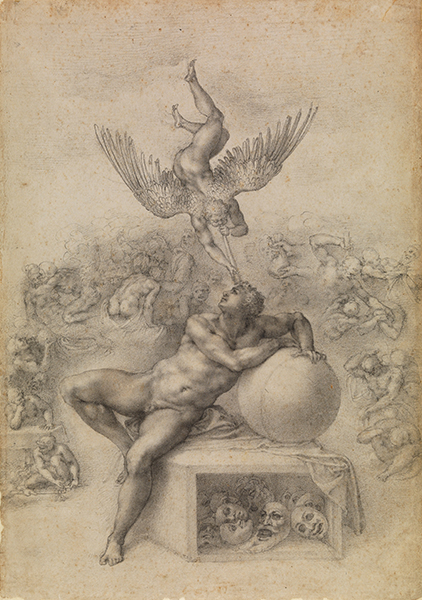This has been a great season for the Renaissance masters. In November, Leonardo’s “Salvator Mundi” sold for a record $450 million at Christie’s in Manhattan And that same month uptown, The Metropolitan Museum of Art opened its blockbuster Michelangelo show of more than 200 works (through Feb. 12).
It’s a tour de force and not just because the exhibit recreates the Sistine Chapel ceiling — a showstopper in any event. But what really makes it sing is its brilliant exploration of the artist as both creator and craftsman. Indeed, the accompanying text tells us that in 1568, biographer Giorgio Vasari hailed Michelangelo Buonarroti (1475-1564) — whose roots lay in the artistic mecca of Florence — for his command of disegno, which encompasses design as both drawing and concept.

The physical component of Michelangelo’s genius is everywhere in the show, mostly in rarefied, ravishing, rapturous drawings, many in the challenging medium of red chalk. There Michelangelo’s acute attention to anatomy is evident in every molded muscle. Though he succeeded as an architect (the dome of the Papal Basilica of St. Peter), a sculptor (“David,” the “Pietà,” “Risen Christ”) and a painter (the aforementioned Sistine ceiling), he saw himself as a sculptor and there is a sculptural quality to his works in other media, particularly the drawings.
As the subtitle of the show, “Divine Draftsman and Designer,” indicates, there is not merely a heavenly hand at work in these but a matchless mind and heart. One of the most haunting works comes fairly early. It’s Michelangelo’s “Study of Adam and Eve” after Masaccio’s “Expulsion From Paradise” fresco. Michelangelo captures the shame and despair of Masaccio’s first couple, all right, but something more. Unlike Masaccio’s Adam, who appears to be wiping his eyes, Michelangelo’s Adam really buries his face in his hands. It’s the gesture of one who understands finally that he has lost something precious in this world — perhaps the most precious thing — and will never get it back.
It’s no secret that men were Michelangelo’s forté; women, not so much. Oh yes, there is the sensual drawing of “Cleopatra in Bust Length,” the fatal snake a sinuous, sensuous continuation of her textured tresses, coiling about one fine, high exposed breast. But most of Michelangelo’s women look like men with breasts superimposed. Consider his drawing of “Leda and the Swan” or the female figure on the left of his Tomb of Giuliano de’ Medici in Florence’s Basilica of San Lorenzo — both with a musculature that would defy a female Olympic athlete and breasts that appear to be stuck on or headed in opposite directions. Talk about a bad boob job.
This is partly because males, rather than females, served as artists’ models in those days. But it’s also about Michelangelo’s sexuality. The show plays straight with his gayness, noting his love for a succession of beautiful young men to whom he wrote passionate poems, some of which are included. (The artist, Vasari wrote, “abhorred making a resemblance true to life, unless the subject was of extraordinary beauty.”)
Among Michelangelo’s most exquisite men is the so-called “Persian Boy,” a red chalk drawing of a “Young Man in Bust Length in Exotic Costume,” seen from the back, his head turned and tilted down to reveal his stunning face in three quarters, crowned by a diadem-like headdress, a dangling earring accentuating the cut of his jaw. There is something about the long lashes shading a pensive, almost sorrowful gaze; the straight slope of the nose, the full, curving mouth resting on the deep cleft of the chin. You can almost imagine Alexander kissing that mouth on a terrace in Babylon’s fabled gardens some half a million midnights ago. (And indeed, the drawing graced the first U.S. edition of the second novel in Mary Renault’s Alexander the Great series, “The Persian Boy.”)
The male nude plays a prominent role in one of Michelangelo’s greatest achievements, the Sistine Chapel ceiling, which he created for Pope Julius II from 1508 to 1512 — a feat recounted in Irving Stone’s novel “The Agony and the Ecstasy” and the subsequent movie starring Charlton Heston as Michelangelo and Rex Harrison as Pope Julius. Contrary to the film’s portrayal, Michelangelo stood on scaffolds for much of the painting rather than lying down. You can imagine the arduousness of the work, neck craning, muscles straining upward as paint dripped down on you. Here prophets, sibyls and ignudi (athletic male nudes) punctuate scenes from the Book of Genesis, with the ignudi among the most arresting figures.

The inclusion of nudity in a religious work — the sublime marriage of the sacred and the profane, as it were — was controversial in Michelangelo’s day, as it has been in our own. When the ceiling frescoes were restored between 1980 and ’99, some cardinals suggested to Pope John Paul II that it was a good time to add a few judicious fig leafs. Fortunately, the pope’s artistic sensibility prevailed.
The Met has reproduced the ceiling in a one-fourth scale model. In the same gallery, viewers will find drawings and color reproductions of the figures that they can then locate on the ceiling — piecing together not only a masterwork but Michelangelo’s creative process. The room is nothing short of a triumph.
But then, so is the whole show. Kudos to organizer and catalog author Carmen C. Bambach, the longtime curator in the Department of Drawings and Prints at The Met, who with her team spent eight years on the show.
It arrives at the right moment. These have not been the best of times for The Met. With the recent departure of director Thomas Campbell, the museum has undergone a painful, much-publicized financial transition. (It’s now on its way to financial solvency and finding a new director, who will report to President and CEO Daniel H. Weiss.)
With a divine salute to the divine Michelangelo, The Met reaffirms its inherent greatness.
For more, visit metmuseum.org.




